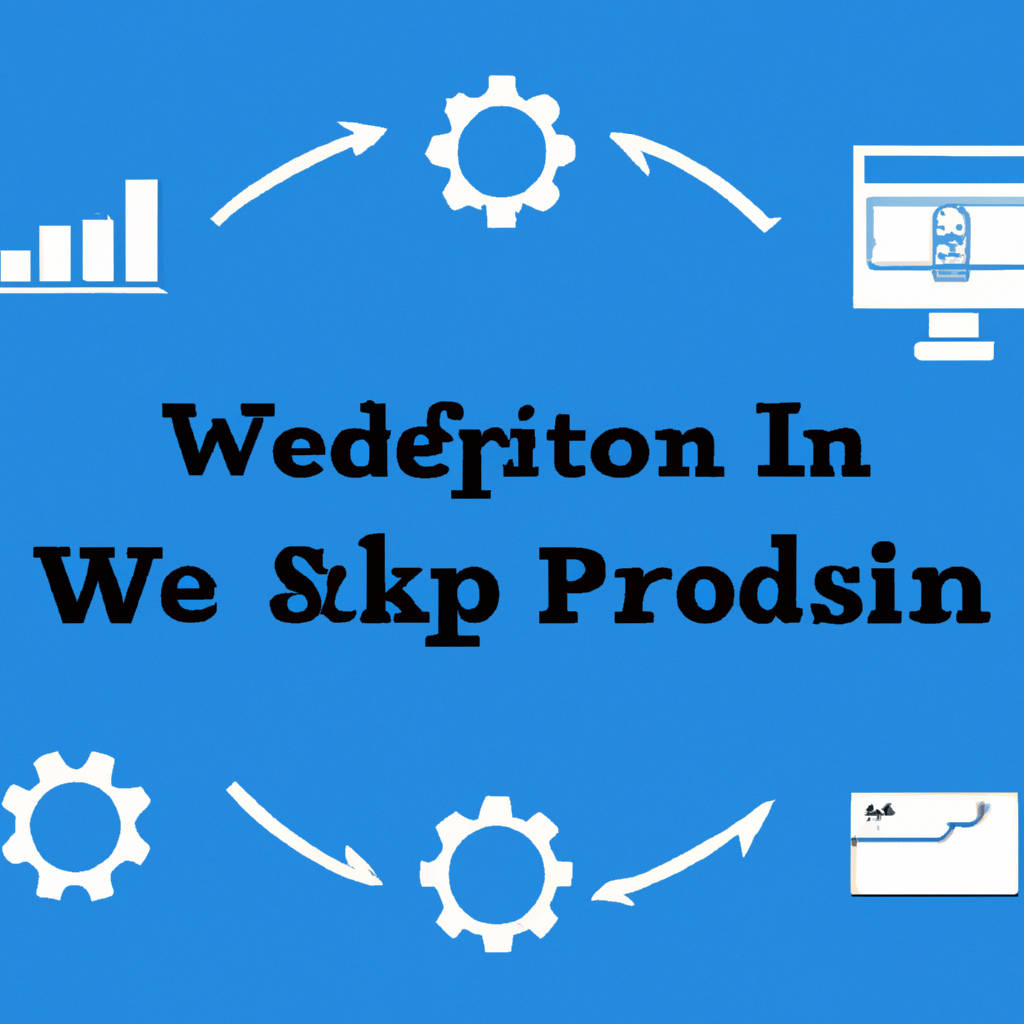Website production process is an intricate sequence of steps that help in the creation and maintenance of a website. The process typically begins with the gathering of information, where the purpose and goals of the website are defined, along with the identification of the target audience. The second stage is planning where a sitemap is created, outlining the main topics and subtopics of the site. The third stage involves the design where the visual layout of the website is created, usually in a graphic suite.
Once the layout is approved, the site development begins. This involves writing valid HTML/CSS code that complies with current web standards, maximizing functionality, and accessibility for users. After the website is built and approved, it is tested to ensure it is optimized for use on various devices and browsers. Post the testing, the website is officially launched and made live for the public.
However, the process doesn’t end here as a good website requires regular maintenance and updates to keep it fresh and in sync with user needs. This includes adding new content, fixing bugs, and making improvements based on user feedback. Therefore, website production is a continuous process that requires careful planning, execution, and maintenance.

Planning and Strategy
Planning and strategy form the backbone of any successful project or endeavor. The process of planning involves setting clear, achievable goals and outlining the steps required to reach them. It requires a thorough understanding of the task at hand, the resources available, and the potential obstacles that may arise.
On the other hand, strategy is the larger, overarching approach adopted to achieve these goals. It involves recognizing and utilizing strengths, overcoming weaknesses, exploiting opportunities, and mitigating threats. This dual process of planning and strategy is crucial in various fields, including business, politics, sports, and even personal life. Without a well-thought-out plan, resources can be wasted, and objectives may be hard to reach. Similarly, without a robust strategy, one may find themselves ill-prepared to face unexpected challenges or seize new opportunities.
Therefore, it is evident that planning and strategy are not only essential but also interdependent. A plan without a strategy is like a ship without a rudder – aimless and directionless. A strategy without a plan, on the other hand, is like a map without a compass – you know where you want to go, but you don’t know how to get there. Hence, for effective outcomes, one must invest an adequate amount of time and effort into both planning and developing a winning strategy.
Research and Analysis
Research and Analysis are fundamental aspects of any intellectual or professional endeavor. They form the backbone of our understanding and knowledge expansion in every field. Research, which involves the systematic investigation into and study of materials and sources to establish facts and reach new conclusions, is the stepping stone of any discovery or invention. It is a meticulous process of inquiry that relies on data collection, interpretation, and validation to answer complex questions, test hypotheses, or disprove theories.
On the other hand, Analysis is the next crucial step that follows research. It is the process of inspecting, cleaning, transforming, and modeling the collected data with the goal of discovering useful information, concluding, and supporting decision-making. Analysis breaks down complex data sets into smaller, understandable components and identifies patterns, trends, and relationships within the data. It is an integral part of the scientific method that enables us to derive meaningful insights from our research and apply these findings to real-world scenarios.
The combination of research and analysis is a powerful tool for problem-solving and decision-making in various sectors, including business, healthcare, education, technology, and more. It helps in understanding the current situation, predicting future trends, and making informed decisions. From developing new technologies to addressing societal challenges, the importance of research and analysis cannot be underestimated. They allow us to explore the unknown, validate the known, and create a path for further discovery. In essence, research and analysis are the pillars of innovation and advancement in today’s knowledge-driven world.
Content Development
Content development involves the research, production, and refinement of information in various formats. This essential aspect of digital marketing aims to deliver valuable, relevant, and consistent content to engage a target audience, eventually leading to profitable customer action. It encompasses a wide array of activities such as brainstorming ideas, creating written text, producing videos, designing graphics, and developing other multimedia elements to express a message effectively. The process is strategic and requires a solid understanding of the target audience’s preferences, behaviors, and needs.
The primary goal of content development is to attract, inform, and engage an audience while promoting the brand subtly. It is a continuous and dynamic process that demands creativity, strategic planning, and meticulous execution. It’s not just about creating high-quality content, but it also involves optimization for search engines, incorporation of relevant keywords, and ensuring a seamless user experience.
Data analytics are also integral to content development, as they provide insights into what type of content performs best, helping businesses make informed decisions. Regularly updating and refreshing content is key to staying relevant in the fast-paced digital world. It’s crucial that content developers stay abreast of the latest industry trends, digital tools, and technologies to enhance their content generation process and meet the continually evolving needs and expectations of their audience.
In summary, content development is more than just creating content; it’s about crafting a compelling narrative that resonates with your audience, reflects your brand’s unique voice, and ultimately drives business growth and success. It’s an ongoing process requiring a blend of creativity, strategy, and technology, with the ultimate aim of delivering value to both the business and its audience.

Design and Wireframing
Design and wireframing are integral components of the process of creating digital products, such as websites, mobile apps, and software. Wireframing, in particular, is a method of creating a simplified visual guide that represents the skeletal framework of a particular digital product. It is a blueprint, a roadmap that designers use to plan the structure and functionality of the digital product. The wireframe typically contains detailed information about the layout of the site or application, including interface elements, navigation systems, and how they work together.
Design, on the other hand, takes the wireframe as a base and incorporates the visual aspects of the digital product. This includes typography, color schemes, graphics, and images. Design is where the aesthetic appeal of the product comes into play, tying in with the functionality to create a seamless user experience.
Both design and wireframing require a high level of creativity, technical skill, and understanding of user behavior. They serve different purposes but are interconnected stages of the product development process. The wireframe sets the groundwork for the design, helping to define the user journey, identify potential challenges, and eliminate unnecessary elements. The design then adds the visual appeal, promoting user engagement and enhancing the overall user experience.
While wireframing focuses on the functionality and user journey, design ensures that the digital product is not only functional but also visually appealing and engaging for the users. Together, design and wireframing ensure that the digital product is user-friendly, aesthetically pleasing, and meets the objectives of the project. In conclusion, design and wireframing are crucial steps in the creation of effective, engaging, and successful digital products.
Development and Coding
Development and coding are integral aspects of the digital world that we inhabit today. From the websites we browse, the applications we use, to the digital infrastructure of the companies we work for, coding is the foundation upon which these technologies are built. Development, in this context, refers to the process of creating, testing, and maintaining a software system. This involves a series of steps, including planning, designing, coding, testing, and maintenance.
On the other hand, coding is the act of writing instructions for computers to execute. It involves the use of various programming languages like Python, Java, C++, and many others. Each language has its unique syntax and purposes, and the selection of a programming language is often dictated by the specific needs of the project at hand.
Coding is not just about writing lines of code; it requires a deep understanding of algorithms, data structures, and problem-solving techniques. Developers must also be able to work collaboratively, as most development projects are undertaken by teams of coders, each with their own areas of expertise. They must also possess strong debugging skills, as identifying and rectifying errors is a common aspect of the development process.
Moreover, the field of development and coding is constantly evolving, with new programming languages, tools, and methodologies emerging regularly. This necessitates continuous learning and adaptability on the part of developers. As we continue to rely more heavily on digital technology in all aspects of our lives, the importance of development and coding is only set to increase. Whether in creating cutting-edge applications, streamlining business processes, or solving complex computational problems, development and coding serve as the cornerstone of digital innovation.
Testing and Quality Assurance
Testing and Quality Assurance are crucial components in the production process of any product, application, or service. They serve as a safeguard to ensure that the output delivered to the end-users meets the defined standard of functionality and usability. Testing is a process where a system or an application is executed in a controlled environment to identify any potential errors or issues. It involves various methodologies such as unit testing, integration testing, functional testing, stress testing, and many others to scrutinize the product from every possible angle.
On the other hand, Quality Assurance is a proactive process that focuses on the improvement of development and test processes to prevent defects. It emphasizes the establishment of a good quality management system and the assessment of its adequacy. The objective is to improve production and test processes so that defects do not arise in the product. Quality Assurance involves activities related to quality management such as auditing, training, and implementation of quality standards.
Both these processes are integral to maintaining the reliability and robustness of the product or service. They help in enhancing customer satisfaction by ensuring that the product meets or exceeds customer expectations. Furthermore, these processes aid in reducing the cost of production by identifying and rectifying defects at an early stage, thereby preventing wastage of resources. Testing and Quality Assurance, though different in their approach, work hand in hand to deliver an impeccable product or service to the end-user. Together, they form a vital part of the product development lifecycle, ensuring that the product is free from defects and performs as expected in the real-world scenario.

Launch and Deployment
The process of launch and deployment is an essential aspect in various fields such as software development, aerospace engineering, and military operations. In the realm of software development, it involves the release of a new or updated application into a production environment where end users can access it. This procedure aims to execute the software’s functionality and ensure it performs as expected. Prior to deployment, rigorous testing is conducted to eliminate potential bugs or system glitches and guarantee smooth operation.
In aerospace engineering, launch and deployment refer to the operation of sending spacecraft or satellites into space. This involves intricate planning and precision, as the spacecraft must reach its designated orbit and function correctly. The process begins on Earth, with the construction and testing of the spacecraft, followed by the launch via a rocket. Once in space, the spacecraft is deployed into its intended orbit. The success of this operation hinges on meticulous planning, scientific knowledge, and advanced technology.
In military terms, launch and deployment could refer to the mobilization of troops or the use of weaponry. Troop deployment involves strategic planning to ensure effective use of resources and safeguard personnel. Meanwhile, the launch of weapons, such as missiles, requires precision and accuracy to achieve the intended objective while minimizing collateral damage.
Across these diverse fields, the process of launch and deployment requires a careful balance of planning, testing, and execution. It is a complex procedure that demands expertise, precision, and a keen understanding of the specific field. Despite the differences in context, the underlying principle remains the same: to successfully introduce a new element into a designated environment for a specific purpose.
Maintenance and Updates
Maintenance and updates are fundamental aspects in various fields such as technology, infrastructure, and equipment. They play a crucial role in ensuring systems and devices function optimally, and can extend their lifespan significantly. When it comes to technology, for instance, software and hardware require regular updates and maintenance to fix issues, enhance performance, and incorporate new features. These updates usually address security vulnerabilities, add functionalities, and improve user interfaces, among other things. They also play a significant role in protecting against cyber threats.
Similarly, in the context of infrastructure, regular maintenance and updates are essential to ensure longevity and prevent the occurrence of potential accidents or breakdowns. For instance, buildings, bridges, roads, and other infrastructure components need periodic inspection and repair to remain safe and functional. Without appropriate maintenance and updates, these structures can deteriorate over time, leading to costly repairs or even replacement.
Maintenance and updates are also critical for various types of equipment, ranging from vehicles to industrial machinery. Regular maintenance can enhance the performance, efficiency, and safety of these machines, while updates could mean adding or replacing parts to improve functionality or conform to new standards.
Despite the obvious benefits, maintenance and updates can sometimes be overlooked due to factors such as cost, time, or simply lack of awareness. However, neglecting these aspects can lead to more serious issues in the long run, including system failure, increased vulnerability to cyberattacks, infrastructure collapse, or equipment malfunction. Therefore, it is fundamental to prioritize and invest in regular maintenance and updates, not only to prevent potential problems but also to ensure optimal performance and longevity.
